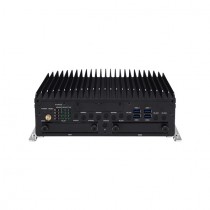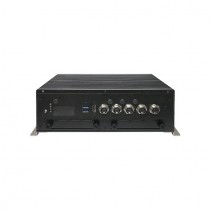Nexcom nROK 1030 Railway Computer
- Intel Atom® x6211E dual-core processor, 6W
- Compact and fanless design
- 5G NR and Wi-Fi 6/6E wireless communication options
- Built-in GNSS receiver
- Built-in 1 x CAN bus 2.0B (optional SAE J1939)
- Smart power management with Ignition on/off delay via software control and low voltage protection
- Dual display outputs and 2.5GbE LAN ports
- 1 x mini-PCIe + 2 x M.2 socket expansion
- Certified by CE, FCC, EN 50155 class OT4
Description
nROK 1030, a compact,
rugged, and entry-level vehicle computer with Intel Atom® x6211E dual-core
processor 1.3GHz/3GHz (burst), is designed for the harsh in-train environment.
Because of the compact design, it is especially for the vehicles with limited
space to locate the computer system, but without compromising with its space to
scarify its features
nROK 1030 has onboard CAN 2.0B for vehicle diagnostics and driver behavior management. An advanced GNSS receiver supports GPS/Glonass/QZSS/Galileo/Beidou. nROK 1030 features optional WLAN Wi-Fi 6/6E/Wi-Fi 5 and WWAN 5G NR/LTE wireless data connectivity. With external micro-SIM socket, it allows user to access micro-SIM card conveniently. 12VDC output can be provided for external display with easy power wire arrangement. nROK 1030 keeps the flexibility to meet different demands for rolling stock applications, such as wireless gateway, infotainment, digital radio data/voice transmission system.
You can place an order for the Nexcom nROK 1030 Railway Computer, which is applicable in the Factory Automation industry, online via one of our Middle East branches (Dubai/ Oman/Saudi Arabia) and get it delivered at a low cost at a specific time.
Specification
| General | |
|---|---|
| CPU | Intel Atom® x6211E dual-core processor, 1.3GHz/3GHz (burst), TDP 6W |
| GNSS and Onboard Sensor | 1 x Default U-blox NEO-M9N GNSS module for GPS+QZSS/Glonass/Galileo/Beidou 1 x 3D accelerometer and 3D gyroscope |
| Expansion | 1 x Full size mini-PCIe socket (USB 2.0, PCIe 3.0/SATA 3.0) 1 x M.2 2230 Key E socket (USB 2.0, PCIe 3.0 x2) 1 x M.2 3042/3050/3052 Key B socket (USB 2.0, USB 3.2 Gen 2) for LTE/5G NR module with 2 x external micro-SIM |
| Operating System | Windows 11/Windows 10/Linux |
| Memory | 1 x 260-pin DDR4 SO-DIMM socket support 3200MHz up to 32GB default 2666MHz, 4GB With In-Band ECC (IBECC) |
| Storage | 1 x 2.5” SATA 3.0 internal drive bay (9.5mm) 1 x mSATA slot (occupied mini-PCIe slot) |
| Computer | |
| Video Output | 1 x HDMI 1.4b up to 3840 x 2160@30Hz 1 x VGA port 1920 x 1200@60Hz |
| Interface | |
| I/O Interface-Front | 6 x LED indicators (including 1 x programmable LED) 1 x USB 3.2 Gen 2 type A (5V/0.9A) 1 x USB 2.0 type A (5V/0.5A) 2 x Externally accessible micro-SIM card sockets with cover 1 x Reset button 1 x Power button 1 x DB9 (COM1) for full RS232/422/485 1 DB9 (AUDIO) for 1 x Mic-in, 1 x Line-out 2 x LAN M12 X-coded, 10/100/1000/2500 Mbps 2 x RP-SMA connector holes for WLAN 1 x SMA connector for GNSS |
| I/O Interface-Rear | 1 x HDMI 1 x VGA 1 x DB9 (COM2) for full RS232/422/485 1 x DB15 (CAN/DIO) - 1 x Isolated CANBus 2.0B - 5 x DI and 4 x DO - Power in for DIO isolation, 9~36VDC 1 x M12 5-pin A-coded DC input with ignition 24 VDC, non-isolation 1 x Connector (4 x 2) for 12VDC/2A output, reset, power button, RS232 (Tx/Rx) 4 x SMA connector holes for WWAN 1 x Ground connector |
| Power Requirement | |
| Power Management | Power input 24VDC w/o isolation Cranking voltage: 6V~9V (< 30 seconds) Reverse protection, OCP & UVP Selectable boot-up & shutdown voltage for low power protection of software Setting 8-level power on/off delay time by software 10~255 seconds WDT support, setup by software SDK (Windows/Linux) including utility and sample code |
| Physical Characteristics | |
| Dimensions | 185mm (W) x 120mm (D) x 50mm (H) |
| Storage temperatures | -40°C to 85°C |
| Humidity | 90% (non-condensing) |
| Vibration Protection | 2g@5~500 Hz (in operation, SSD) Operating: MIL-STD-810H, Method 514.8C, Procedure 1, Category 4, common carrier US highway truck vibration exposure Storage: MIL-STD-810H, Method 514.8E, Procedure 1, Category 24, minimum integrity test |
| Shock Protection | Operating: MIL-STD-810H, Method 516.8, Procedure I, functional shock=40g Non-operating: MIL-STD-810H, Method 516.8, Procedure V, crash hazard shock test=75g |
| Operating temperatures | EN 50155, class OT4 (-40°C~70°C), 85°C for 10 minutes (w/ 6W TDP CPU, industrial SSD) with air flow |
| Weight | 1.25kg |
| Standards/Certifications | CE FCC Class A EN 50155: 2017 - Ambient temperature EN 50155, Class OT4 (-40°C~70°C), 85°C for 10 minutes - Interruptions of voltage supply class S1 - Supply change over class C1, C2 - EMC EN 50121-1: 2017, EN 50121-3-2: 2016+A1: 2019 - Environment EN 60068-2-1, EN 60068-2-2, EN 60068-2-30 - Shock and vibration IEC 61373 Class B - Protective coating class PC1 (PC2, by request) EN 45545-2:2020 (PCB) |
| Security | |
| Security | TPM 2.0: Infineon SLB9670VQ2.0 FW7.62 |









